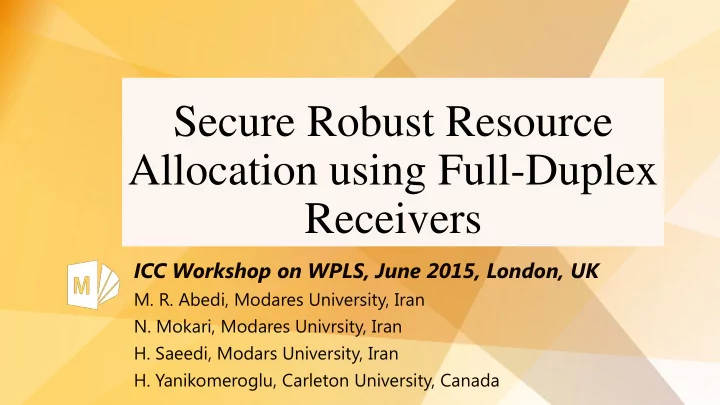

Secure Robust Resource Allocation using Full-Duplex Receivers ICC Workshop on WPLS, June 2015, London, UK M. R. Abedi, Modares University, Iran N. Mokari, Modares Univrsity, Iran H. Saeedi, Modars University, Iran H. Yanikomeroglu, Carleton University, Canada 1
Motivation PHY security Artificial noise: MIMO / Jamming Relay Robustness against CSI uncertainty FD receivers FD receivers used as jammers: no comparison has been ever made 2
Full-Duplex Receiver Sender/Receiver Sender/Receiver 3
Robustness against CSI Uncertainty Channel Mismatch: 2 ≤ ε 𝐡 se 𝑡𝑓 2 𝑓 𝒉 𝑡𝑓 = 𝒉 𝑡𝑓 − 𝒉 ℰ 𝐡 se = e 𝐡 se : e 𝐡 se 2 2 𝑘𝑓 𝑓 𝒉 𝑘𝑓 = 𝒉 𝑘𝑓 − 𝒉 ℰ 𝐡 je = {e 𝐡 je : e 𝐡 je ≤ ε 𝐡 je 2 ≤ ε 𝐡 de 𝑒𝑓 𝑓 𝒉 𝑒𝑓 = 𝒉 𝑒𝑓 − 𝒉 2 ℰ 𝐡 de = {e 𝐡 de : e 𝐡 de 4
Literature on Cooperative Jamming (Perfect CSI) L. Dong, Z. Han, A. P . Petropulu , and H. V. Poor, “Improving wireless physical layer security via cooperating relays,” IEEE Transactions on Signal Processing, vol. 58, no. 3, pp. 1875 – 1888, March 2010. G. Zheng, L. C. Choo , and K. K. Wong, “Optimal cooperative jamming to enhance physical layer security using relays,” IEEE Transactions on Signal Processing, vol. 59, no. 3, pp. 1317 – 1322, March 2011. I. Krikidis , J. S. Thompson, and S. McLaughlin, “Relay selection for secure cooperative networks with jamming,” IEEE Transactions on Wireless Communications, vol. 8, no. 10, pp. 5003 – 5011, October 2009. J.Vilela , M. Bloch, J. Barros, and S. W. McLaughlin, “Wireless secrecy regions with friendly jamming,” IEEE Transactions on Information Theory, Forensics Security, vol. 6, no. 2, pp. 256 – 266, Januray 2011. 5
Literature on Cooperative Jamming (Perfect CSI) S. Gerbracht, C. Scheunert, and E. A. Jorswieck , “Secrecy outage in MISO systems with partial channel information,” IEEE Transactions on Information Theory, Forensics Security, vol. 7, no. 2, pp. 704 – 716, April 2012. S. Luo, J. Li, and A. Petropulu , “Outage constrained secrecy rate maximization using cooperative jamming,” Statistical Signal Processing Workshop (SSP), Ann Arbor, MI, USA, August 2012. Z. Ding, M. Peng, and H.- H. Chen, “A general relaying transmission protocol for MIMO secrecy communications,” IEEE Transactions on Communications, vol. 60, no. 11, pp. 3461 – 3471, November 2012. Y. Liu, J. Li, and A. P . Petropulu , “Destination assisted cooperative jamming for wireless physical- layer security,” IEEE Transactions on Information Forensics and Security, vol. 8, no. 4, pp. 682 – 694, April 2013. 6
Literature on Cooperative Jamming (Imperfect CSI) J. Huang and A. L. Swindlehurst , “Robust secure transmission in MISO channels based on worst- case optimization,” IEEE Transactions on Signal Processing, vol. 60, no. 4, pp. 1696 – 1707, April 2012. L. Zhang, Y.- C. Liang, Y. Pei, and R. Zhang, “Robust beamforming design: From cognitive radio MISO channels to secrecy MISO channels ,” in Proc. Global Telecommunications Conference, (GLOBECOM), November 2009, pp. 1 – 5. B . Yang, W. Wang, B. Yao, and Q. Yin, “Destination assisted secret wireless communication with cooperative helpers,” IEEE Signal Processing Letters, vol. 20, no. 11, pp. 1030 – 1033, November 2013. 7
Literature on FD jamming W. Li, M. Ghogho, B. Chen, and C. Xiong , “Secure communication via sending artificial noise by the receiver: Outage secrecy capacity/region analysis,” IEEE Communications Letters , vol. 16, no. 10, pp. 1628 – 1631, October 2012. G . Zheng, I. Krikidis, J. Li, A. P . Petropulu, and B. Ottersten, “Improving physical layer secrecy using full- duplex jamming receivers,” IEEE Transactions on Signal 8
The he HD HD Sc Scen enario ario 𝑸𝒔𝒑𝒄𝒎𝒇𝒏 𝓟 𝑰𝑬 : max min 𝑆 𝑡 , 𝑹 𝑡 ∈𝓡 𝑡 𝑓 𝒉𝑡𝑓 ∈ℰ 𝒉𝑡𝑓 𝑇 . 𝑢 . 𝑢𝑠 𝑹 𝑡 ≤ 𝑄 𝑡 , 2 ≤ ℰ 𝒉 𝑡𝑓 2 , 𝑓 𝒉 𝑡𝑓 𝑹 𝑡 ≽ 𝟏 . 9
The he HD HDJ J Sc Scen enario ario 𝑸𝒔𝒑𝒄𝒎𝒇𝒏 𝓟 𝑰𝑬𝑲 : max min 𝑆 𝑡 , 𝑹 𝑡 ∈𝓡 𝑡 , 𝑹 𝑘 ∈𝓡 𝑘 𝑓 𝒉𝑡𝑓 ∈ℰ 𝒉𝑡𝑓 , 𝑓 𝒉𝑘𝑓 ∈ℰ 𝒉𝑘𝑓 𝑇 . 𝑢 . 𝑢𝑠 𝑹 𝑡 ≤ 𝑄 𝑡 , 2 ≤ ℰ 𝒉 𝑡𝑓 2 , 𝑓 𝒉 𝑡𝑓 𝑹 𝑡 ≽ 𝟏 , 𝑢𝑠 𝑹 𝑘 ≤ 𝑄 𝑘 , 2 2 , 𝑓 𝒉 𝑘𝑓 ≤ ℰ 𝒉 𝑘𝑓 𝑹 𝑘 ≽ 𝟏 . 10
The he FD Sc D Scen enario ario 𝑸𝒔𝒑𝒄𝒎𝒇𝒏 𝓟 𝑮𝑬 : max min 𝑆 𝑡 , 𝑹 𝑡 ∈𝓡 𝑡 , 𝑹 𝑒 ∈𝓡 𝑒 𝑓 𝒉𝑡𝑓 ∈ℰ 𝒉𝑡𝑓 , 𝑓 𝒉𝑒𝑓 ∈ℰ 𝒉𝑒𝑓 𝑇 . 𝑢 . 𝑢𝑠 𝑹 𝑡 ≤ 𝑄 𝑡 , 2 ≤ ℰ 𝒉 𝑡𝑓 2 , 𝑓 𝒉 𝑡𝑓 𝑹 𝑡 ≽ 𝟏 , 𝑢𝑠 ( 𝑹 𝑒 ) ≤ 𝑄 𝑒 , 2 ≤ ℰ 𝒉 𝑒𝑓 2 𝑓 𝒉 𝑒𝑓 , 𝑹 𝑒 ≽ 𝟏 , 11
Simulation Setup Parameter Value 𝑂 𝑡 = 𝑂 𝑒 = 𝑂 𝑘 4 2 = 𝜏 𝑓 2 0 𝑒𝐶 𝜏 𝑒 2 = ℰ 2 0.5 2 ℰ = ℰ 𝒉 𝑡𝑓 𝒉 𝑒𝑓 𝒉 𝑘𝑓 12
Simulation Results: Effect of Source-Eavesdropper Distance on the performance 13
Simulation Results: Effect of Source-Jammer Distance on the performance Eavesdropper location is fixed at (30,0) 14
Simulation Results: Effect of Source-Jammer Distance on the performance Eavesdropper location is fixed at (70,0) 15
Conclusion Preference of deploying the FD scenario over CJ, or vice versa, highly depends on where the jammer and eavesdropper are located. If the jammer can be placed close enough to the eavesdropper, a better performance is achieved compared to the FD system. Otherwise, the FD scenario can generally take over which is very favorable from practical point of view as we can remove the need for an extra network node. 16
Recommend
More recommend